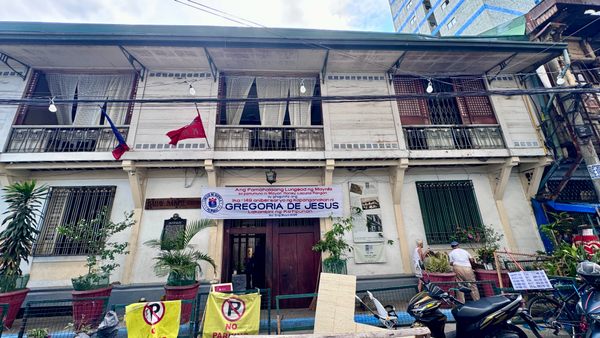The Quiapo district of Manila is located just outside the walled city of Intramuros. It became a natural extension when the city was expanding during the Spanish colonial times, and it was the address of choice for the well-heeled Filipino mestizo families, especially at Hidalgo Street, where rows of bahay na bato (house of stone) competed against each other in terms of grandeur and size. Many of these houses now lie in various states of decay. But the most prominent one, the century-old Bahay Nakpil-Bautista (Nakpil-Bautista House) still stands.
Built in 1914 by Arcadio Arellano for Dr. Ariston Bautista and his wife Petrona Nakpil, the house sat on two lots with a total area of 500 square meters (5,400 square feet). It’s a typical style for its period—two stories, with the lower story serving as the zaguan, or parking area for horse-drawn carriages. The stones on the ground floor came from Mexico, and a few pieces of colorful tiles before the stairs came from Spain.
A short set of stairs leads to an elevated sala (living room), a room that serves as a workshop, and a bedroom. The lower story is made of stone and wood. A main stairway brings you to the second story, where the main hall is located to the right and the kitchen and dining area to the left. On both wings are several rooms for the many inhabitants of the house. Large windows in the living room provide a free-flowing circulation of air throughout the house—there were no air conditioning units at the time this house was built.
Several key figures in Philippine history have lived in the Nakpil-Bautista House. Dr. Ariston Bautista, who commissioned the house, was one of the first professors at the University of the Philippines and also invented a medicine to combat cholera. The legendary Gregoria de Jesus, widow of Andres Bonifacio, who founded the revolutionary armed Kataastaasan Kagalang-galang na Katipunan ng mga Anak ng Bayan (KKK) was a leading figure of the women’s arm of the organization. After Bonifacio died, she married the musician Julio Nakpil.
The house survived the Japanese bombing in World War II, which damaged 70 percent of Manila. The Nakpil-Bautista family moved out of the house in the 1960s. It has since been used as a community center, a museum, and a classroom for children from the surrounding area during the COVID-19 pandemic. The museum showcases the history of Quiapo, the Nakpil-Bautista family, and the Philippine Revolution.
The National Historical Commission of the Philippines declared the house a cultural property on August 25, 2011. Besides the historical value of the house, it is worth visiting as a perfect representation of the architectural style prevailing during the Spanish colonial period and the early 19th century.


